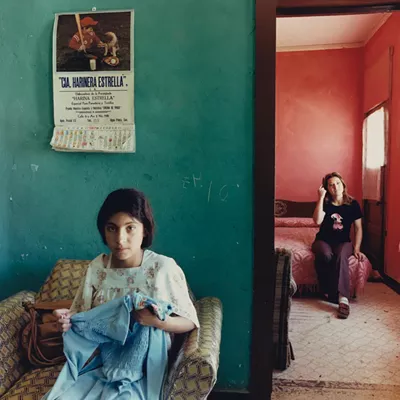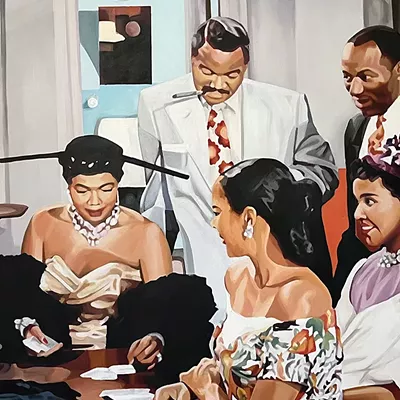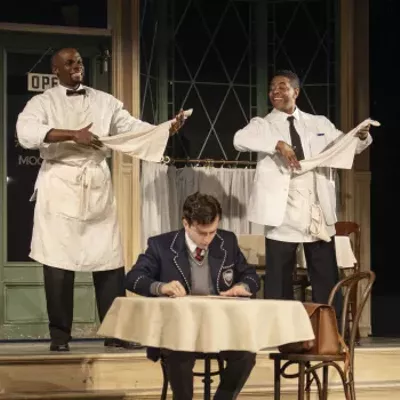Andrea Jensen likes to paint big. Really big.
Her three mixed-media paintings in the 2011 UA Master of Fine Arts Thesis Exhibition at Joseph Gross Gallery are all at least 7 feet high, and one of them is 14 feet long. But these three works—made of painted and collaged pieces of vinyl harvested from recycled billboards—are dwarfed by a fourth work.
That one, "Convenience From the Faraway Nearby," is so big that Jensen couldn't fit it into the gallery even if she wanted to. It's 14 feet high and a whopping 40 feet long. Definitely billboard size. In fact, it is a billboard, soaring high into the air above the Alvernon Way overpass on the south side of town. The towering Catalinas in the distance are a mere backdrop to the art.
"I always wanted to do something large in the landscape," Jensen says modestly.
On a blazing late-April day, Jensen has planted herself in the landscape just south of "Convenience." The billboard is in a hot, unshaded no-man's land, no-so-charmingly called Refinery Way. At left are a dozen gigantic white oil tanks that give the place its name. The overpass curves to the right, and beyond are railroad tracks where, before long, a freight train rattles by.
"Trains go right under it," Jensen says with satisfaction.
Her sky-high artwork is inspired by one of the abstracted landscape paintings back in the university gallery, but for safety reasons, she had to abandon her usual art technique of painting and cutting and reassembling.
"Painting on the (billboard) platform was not an option," she says. So she used Photoshop to create the big work on the small screen. She transmitted the finished image to the billboard company, where technicians printed it out on a long furl of vinyl and installed it on the frame.
What "Convenience" has in common with the earthbound indoor paintings is a preoccupation with what humans are doing to the natural world.
"My paintings are always about how we treat the landscape," Jensen says, "how we treat the physical and psychic landscape."
This one is more realistic than most of her works. A blue sky rolls across mountains that look a lot like the Catalinas directly behind them, and a dun-colored desert floor matches the dry earth below. But it's hardly an unadulterated landscape.
White oil tanks—mirroring the real-life ones at the adjoining Kinder Morgan Energy Partners refinery—are stretched across the artwork's horizon, and a throng of black freight rail cars are parked below.
Most ominous of all, thick black oil is seeping down across the blue desert sky, threatening to engulf the whole place.
The oil spill in the Gulf of Mexico last year inspired the piece, Jensen says, but the "bigger picture is of consumption and the way it leads to the destruction of the landscape."
Too much of our open space is given over to drilling and mining, she notes, and our insatiable desire for material goods fuels the demand for oil, which in turn triggers environmental disasters like the Gulf of Mexico oil spill.
"Oil is a metaphor for our habits," she says. "I hope people who see it will have a moment of reflection and just think a little. Look at how we're treating our landscape."
And what better medium for her message than a billboard? Jensen regularly buys used billboard vinyl pieces to use in her paintings. (Clear Channel Communications, which owns the billboard and many others, "has stacks of them," she says. "Farmers use them to cover their hay.") And billboard advertisements blight the view. Their pictures of products block the land, or, as her title suggests, their "nearby" images obliterate the faraway.
Funded by a competitive grant she won from the UA, Jensen began searching for a billboard "where I could respond to the location."
Her contact at Clear Channel was a little puzzled at first by her idea, but once she got the OK, she quickly settled on Refinery Way and reserved the month of April to overlap with the university's MFA show. Her gallery paintings are full of details, fractured into shards of color, and Jensen found she need to enlarge and simplify to make the big work "read" to an audience zooming by at 55 mph.
"I simplified the shapes and brought in realistic elements like the oil-storage tankers. I used strong contrasts—black blacks, white whites—and used a lot of repetition. I wanted to mirror as much of the landscape as I could."
Jensen realizes the passers-by who are inured to the advertising messages on billboards might not notice her artwork, but "that's a risk I take," she says. "Maybe I'll reach some people. An important component of the project is putting art in a public space, not just in a place where people are expecting to see art. And maybe I'll reach people who don't usually get to see art."
Back at Joseph Gross, Jensen has tried to create an interaction between the paintings and the billboard. A video she shot at Refinery Way fills the gallery with the roar of cars and the clatter of trains, and postcards and maps invite the viewer to take the trip to the southside. She shares the gallery space with two other brand-new MFAs, Erin Garber-Pearson and Seoyeong Cho (Gupton); nine others have work on view at the University of Arizona Museum of Art across the way.
Jensen got her bachelor's degree in painting at the University of Iowa and came to the UA because of the strength of its painting faculty, including Barbara Penn, Dimitri A. Kozyrev and Lawrence Gipe.
"I worked with all the painting professors," she says. "They were very supportive. (Sculptor) Jim Cook was influential; his theoretical ideas pushed my work into different directions."
Gipe, one of the professors who recommended Jensen for the grant, praises her work as "visually strong. It's a cool project. She's busting out, actually, with gallery offers in Chicago and Los Angeles."
After she gets her master's in May, Jensen, 31, and her husband are considering a move back to Chicago, where she grew up in the far northwestern suburbs. She's already taught art, to elementary and high school kids in Colorado, before starting on her master's degree, and she hopes eventually to get a college teaching job.
For now, she's still giddy about her biggest project to date.
"It was exciting to watch the installation, to see it as it unrolled," she says. And she's still learning how "Convenience" looks at different times of day. In late afternoon, shadows play across the surface. At night, like the refinery next door, it's lit up in the darkness.
When the billboard's run is over on May 5, Jensen plans to practice what she preaches when it comes to consumption: The vinyl may just find its way into new paintings that are sliced and diced and re-glued.
"I can recycle this one to make more," she says.










